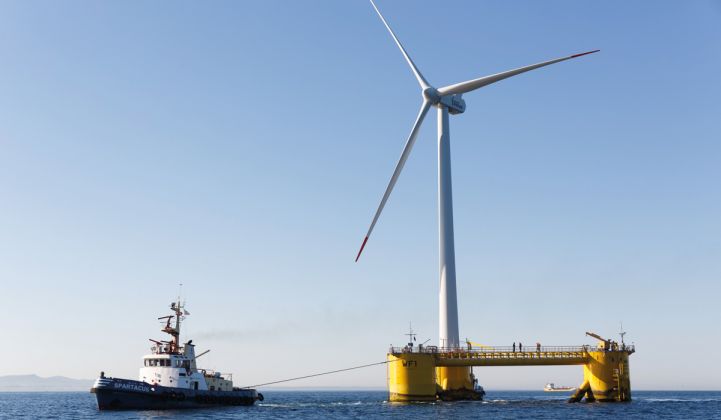The U.S. is late to the offshore wind party compared to Europe and China. And the injection of new regulatory uncertainty in the shape of permitting delays at Vineyard Wind's 800-megawatt project won't help firm up supply-chain investment.
Many of the largest U.S. offshore wind projects are backed by European developers, and most of the largest pieces of equipment will be imported from Europe for the foreseeable future.
But there is one area of offshore wind that's new enough that even a latecomer could make its mark: floating.
Floating offshore wind remains a largely precommercial endeavor because it hasn't yet been needed in the shallow waters off China and Western Europe. In the U.S., however, floating technology is pretty much the only option for the whole of the Pacific.
North American developers such as Castle Wind and Northland Power are vying with Europe’s offshore wind giants for a piece of the action. Market intelligence group Quest Floating Wind Energy believes almost 2.4 gigawatts of floating wind could be installed off U.S. shores over the next decade.
The floating market is in its very earliest days. But here are seven projects to keep an eye on, all of which would help give the U.S. a seat at the floating offshore wind table as the market matures.
Maine Aqua Ventus
Likely the first U.S. floating wind plant to go live if it stays on track for a 2022 completion, Maine Aqua Ventus is a 12-megawatt demonstration project developed by the University of Maine and construction firm Cianbro.
As the only approved floating project in the U.S., and located in state waters, it will feature two 6-megawatt turbines on concrete semi-submersible hulls designed by the university.
This summer, the development group told GTM it expects to bring a bigger investor onto the project sometime this fall, ahead of a possible expansion of the project into new phases.
Magellan Stiesdal
Leading the charge to install floating wind platforms off the West Coast is Magellan Wind, a U.S. developer led by former Deepwater Wind managing director Jim Lanard.
Lanard's company is planning to have 30 megawatts of capacity on Californian waters by 2023, using a Tetraspar floating platform developed by Stiesdal Offshore Technologies of Denmark. But like all Californian projects, it would first need to win a lease for a development zone in what's expected to be an intensely competitive auction scheduled for 2020.
Redwood Coast
Racing Magellan to the Pacific Ocean is the public-private Redwood Coast offshore wind consortium made up of Redwood Coast Energy Authority, EDPR North America, Principle Power, Aker Solutions, H. T. Harvey & Associates and Herrera Environmental Consultants.
The consortium is planning to install at least 150 megawatts of wind on Principle Power’s WindFloat semisubmersible platforms. Quest Floating Wind Energy believes it could get steel in the Humboldt Bay by around 2024.
Castle Wind
Of all the U.S. plans for floating offshore wind, Castle Wind’s proposal for a gigawatt of capacity in Morro Bay in central California is by far the most ambitious. The developer is a joint venture between Trident Winds and German utility group EnBW.
Castle Wind last month took the first step toward an offtake agreement with a memorandum of understanding with local utility Monterey Bay Community Power. Pending next year’s planned California lease auction, the project could start delivering by around 2025.
Progression South
As with California, developers couldn’t wait for a Bureau of Ocean Energy Management (BOEM) lease auction to express an interest in floating offshore wind projects off Hawaii. Progression Hawaii Offshore Wind submitted its first unsolicited application in 2015.
The company hopes to install between 40 and 50 turbines on WindFloat platforms, for a total capacity of around 400 megawatts, potentially by 2025.
Oahu North
Alpha Wind Energy subsidiary AW Hawaii Wind got its unsolicited application for Hawaiian offshore wind in even before Progression, although Quest Floating Wind Energy expects its 400-megawatt Oahu North project to go live a little later than Progression’s, in 2026.
Like the Progression project, Oahu North is set to use WindFloat foundations for its 42 turbines.
Oahu South
AW Hawaii Wind is hoping to follow its Oahu North project with a similar-sized plant to the south of the island in 2028, although in its application the company noted that the area could be subject to military restrictions.
Truth be told, the likelihood of all of these projects remains speculative, and the timeframes even more so given BOEM’s decision to review the entire permitting process.
For all the West Coast’s potential, “not a single project has been awarded as yet in the U.S. Pacific,” noted Erik Rijkers, market development and strategy director at Quest Floating Wind Energy.
***
Wood Mackenzie is hosting an invite-only analyst briefing on the U.S. offshore wind sector in Boston the morning of Wednesday, October 23. Email [email protected] to express interest in attending.




